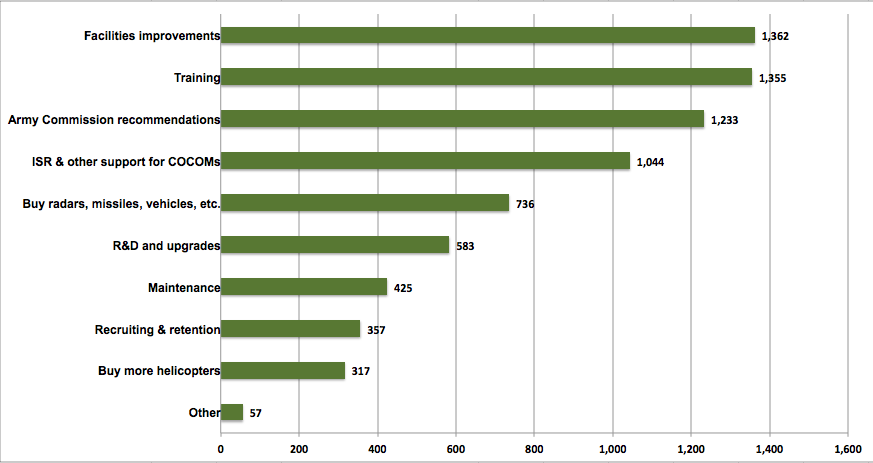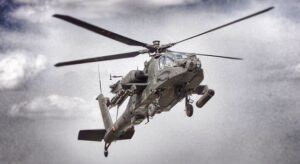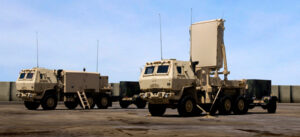Army’s $7.5B Unfunded Wish List: Guard Apaches & Anti-Russian Radars
Posted on

Army 2017 unfunded requirements, in millions
UPDATED with comment from Army Commission & National Guard Association of the US
WASHINGTON: The Army $7.5 billion wishlist for Congress, obtained by Breaking Defense, of needs that didn’t fit in its 2017 budget includes $1.64 billion for new weapons and $1.2 billion to implement the recommendations of the National Commission on the Future of the Army to retain four National Guard attack helicopter battalions and an active duty Combat Aviation Brigade. The Army had planned to go down from 11 CABs to 10 and from eight Guard Apache battalions to zero.

AH-64E Apache
The two biggest unfunded requirements, at just over $1.3 billion apiece, are improvements to the Army’s sequester-ravaged training program and its long-neglected installations. Readiness has been the unchallenged top priority for the Army Chief of Staff, Gen. Mark Milley, but the Army has had to cut back on training in recent years. The Army’s infrastructure, by contrast, has been a low priority and a chronic bill payer for other needs, leading to alarming accumulations of deferred maintenance.
Just over $1 billion would go to improve Army support to Combatant Commanders around the world. The money would go primarily for Intelligence, Surveillance and Reconnaissance (ISR), such as that conducted by the Army’s version of the Predator, the Grey Eagle.
Roughly $735 million would go to buying additional weapons systems, including the kinds of counter-artillery radars and rocket artillery used to great effect in Ukraine.

Q-53 counterbattery radar (Lockheed Martin)
Another $317 million in procurement dollars would go to buying more helicopters, partially compensating for cuts in this year’s budget. And there’s $583 million for research and development..
That procurement money is quite separate from the $796 million in additional aircraft required to implement the National Commission recommendations. The rest of the $1.2 billion cost of the Army Commission reforms would go to manning, maintaining, and training the helicopter units that otherwise would have been disbanded.
It’s worth noting the commission made many other recommendations that would require funding, notably shoring up SHORAD, Short-Range Air-Defense against such threats as Russian drones. If the Army’s asking for money for these other recommendations, it’s buried in the broad categories of the document. Cybersecurity, also, is referred to in several places but there’s no overall figure.
We’re still awaiting comment from the commission, but the Army’s costing here seems to roughly correlate with the commissioners’: Their report estimated retaining the active and Guard aviation units would cost $4 billion over five years, but much of that would be front-loaded because of the need to buy additional aircraft. The whole active-vs.-Guard debate began when the Army decided it had to retire its aging OH-58 Kiowa scout helicopters without buying a replacement and would instead take Guard Apaches to fill regular Army reconnaissance squadrons.
UPDATE The National Guard Association of the US, which has been at the forefront of the fight to keep the Guard’s Apaches, welcomed the unfunded requirements list. “Seeing the four Apache battalions in a UFR is certainly a positive development,” NGAUS spokesman John Goheen told me.
“We certainly understand the Army budget was done, the ink was dry, prior to the publication of the Army commission’s recommendations,” Goheen said. “So the Army budget request does not include anything from the Army commission.” The unfunded requirements list was the first place the Army could request funding to act on the commission’s recommendations, he said, and that it has taken that opportunity is encouraging.
A spokesman for the commission itself offered cautious comment. “The Commission cannot vouch for the accuracy of the Army’s numbers or whether the Army applied offsets for aviation funding, for example slowing Blackhawk modernization,” Joseph Eule told me. (The commission recommended cutting back on UH-60 Black Hawk utility helicopters to save money for Apache gunships). “However, the Commission did make it clear that many of its high-priority aviation initiatives would require significant funding.”
“The four UFR requests attributed to the NCFA reflect several specific NCFA recommendations and the general theme of the report,” Eule said. “The Aviation Modernization UFR reflects Recommendation 60; the Eleven Combat Aviation Brigades UFR reflects Recommendation 17; the Apache UFR reflects Recommendation 57; and the National Guard Readiness UFR reflects the Commission’s view that: ‘…the reserve components must be resourced to provide both needed operational capability and the strategic depth the nation requires in the event of a full mobilization for unforeseen requirements. These forces should be maintained at currently planned readiness levels…'”
“What the army commission did is they provided a framework,” said Goheen. “There’s a lot of good recommendations there.”
“Now is the hard part,” he said: “finding a way to do these things…. in this budget environment.”
Subscribe to our newsletter
Promotions, new products and sales. Directly to your inbox.
